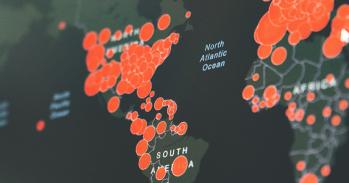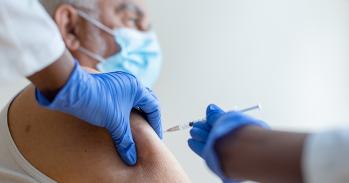
Monoclonal antibodies – treatments developed by cloning a cell that makes an antibody – could help provide an answer to the growing problem of antimicrobial resistance, say scientists.
Monoclonal antibodies – treatments developed by cloning a cell that makes an antibody – could help provide an answer to the growing problem of antimicrobial resistance, say scientists.
We know that monoclonal antibodies are safe and that they work, and the technology exists to produce them – what we have done is identify how to hit bacteria with them
Stephen Baker
A team lead by researchers at the University of Cambridge has developed a monoclonal antibody drug, using a technique involving genetically engineered mice, that may help prevent infection from Acinetobacter baumannii, a bacteria associated with hospital-acquired infections, which is particularly common in Asia.
A. baumannii bacteria can cause life-threatening respiratory illness and sepsis in vulnerable individuals, particularly in newborn babies whose immune systems have not fully developed. It is usually spread through contaminated surfaces, medical equipment and via contact with others. In recent years infections with strains of this bacteria that are resistant to almost every antibiotic available have become common.
Professor Stephen Baker from the Cambridge Institute of Therapeutic Immunology and Infectious Disease at the University of Cambridge said “A. baumannii is good at sticking to medical equipment, and if people are vulnerable or don't have a particularly well-developed immune system, they can succumb to this infection and get aggressive pneumonia requiring ventilation – and in many cases, the patients can acquire the infection from the ventilation itself.
“The bacteria are naturally resistant to many antimicrobials, but as they’re now found in hospitals, they’ve acquired resistance to almost everything we can use. In some hospitals in Asia, where the infections are most common, there isn't a single antibiotic that will work against them. They’ve become impossible to treat.”
In a study published today in Nature Communications, the team produced monoclonal antibodies using transgenic mice – mice that have been genetically-engineered to have a human-like immune system, producing human antibodies instead of mouse antibodies. They went on to show that these monoclonal antibodies were able prevent infection with A. baumannii derived from clinical samples.
Monoclonal antibodies are a growing area of medicine, commonly used to treat conditions including cancer (for example, Herceptin for treating some breast cancers) and autoimmune disease (for example, Humira for treating rheumatoid arthritis, psoriasis, Crohn's disease, and ulcerative colitis).
Usually, monoclonal antibodies are developed from the antibodies of patients who have recovered from an infection, or they are designed to recognise and target a particular antigen. For example, monoclonal antibodies targeting the ‘spike protein’ of the SARS-CoV-2 coronavirus were explored as a way of treating COVID-19.
In the approach taken by the Cambridge team, however, transgenic mice were exposed to the outer membrane of A. baumannii bacteria, triggering an immune response. The researchers then isolated almost 300 different antibodies and tested which of these was the most effective at recognising live bacteria, identifying the single monoclonal antibody mAb1416 as the best.
Professor Baker said: “Using this method, we don't infect the mice with the live bacteria, but we instead immunise them using multiple different elements and let the mouse’s immune system work out which ones to develop antibodies against. Because these mice have ‘humanised’ immune systems, we wouldn’t then need to reengineer the antibodies to work in humans.”
The team treated mice with mAb1416, and 24 hours later exposed them to A. baumannii isolated from a child with sepsis in an intensive care unit. They found that those mice treated with the drug saw a significant reduction in bacterial load in their lungs a further 24 hours later, compared to mice that were not treated.
All of the isolates used to produce and test the monoclonal antibodies were from patients in Ho Chi Minh City, Vietnam, but the isolate used to test mAb1416 was taken from a patient ten years later than the other isolates. This is important because it shows that mAb1416 was protective against A. baumannii bacteria that may have evolved over time.
Professor Baker said: “Using this technique, you can take any bacterial antigen or cocktail of antigens, rather than waiting for somebody that's recovered from a particular infection – who you assume has developed an appropriate antibody response – give it to the mice and extract the antibodies you think are the most important.”
More work is now needed to understand the mechanism by which mAb1416 protects against infection, as this could allow the team to develop an even more effective treatment. Any potential new drug will then need to be tested in safety trials in animals before being trialled in patients.
Professor Baker added: “We know that monoclonal antibodies are safe and that they work, and the technology exists to produce them – what we have done is identify how to hit bacteria with them. Apart from the cost effectiveness, there's no reason why this couldn’t become a medicine within a few years. Given the emergency presented by antimicrobial resistance, this could become a powerful new weapon to fight back.”
The research was funded by the Bill & Melinda Gates Foundation, the UK Medical Research Council Newton Fund, the Viet Nam Ministry of Science and Technology, and Wellcome.
Professor Baker is a fellow at Wolfson College, Cambridge.
Reference
Baker, S, Krishna, A & Higham, S. Exploiting human immune repertoire transgenic mice to identify protective monoclonal antibodies against an extensively antimicrobial resistant nosocomial bacterial pathogen. Nat Comms; 12 Sept 2024; DOI: 10.1038/s41467-024-52357-8

The text in this work is licensed under a Creative Commons Attribution-NonCommercial-ShareAlike 4.0 International License. Images, including our videos, are Copyright ©University of Cambridge and licensors/contributors as identified. All rights reserved. We make our image and video content available in a number of ways – on our main website under its Terms and conditions, and on a range of channels including social media that permit your use and sharing of our content under their respective Terms.




